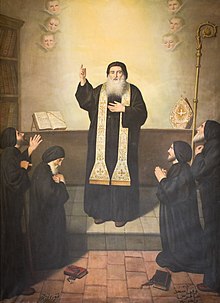Maron | |
|---|---|
 19th-century depiction of Saint Maron | |
| Born | Unknown Coele Syria, Eastern Roman Empire |
| Died | 410 AD[1] Kalota, Coele Syria, Eastern Roman Empire |
| Venerated in | Catholic Church (especially Maronite Church) Eastern Orthodox Church |
| Feast | February 9 (Maronite Church)[2][3]
February 14 (Eastern Orthodox Church)[4] |
Maron, also called Maroun or Maro (Syriac: ܡܪܘܢ, Mārūn; Arabic: مَارُون; Latin: Maron; ‹See Tfd›Greek: Μάρων), was a 4th-century Syriac Christian hermit monk in the Taurus Mountains whose followers, after his death, founded a religious Christian movement that became known as the Maronite Church, in full communion with the Holy See and the Catholic Church.[5] The religious community which grew from this movement are the modern Maronites.
Maron, revered as a highly spiritual ascetic monk with a connection to God through his communion with the natural environment, garnered widespread respect within Christian circles. In addition to his emphasis on ascetic spirituality, he played an important role in advancing Christian missions in the region. One of his disciples, Abraham of Cyrrhus, emerged as a missionary, successfully disseminating the Maronite variant of Christianity in Lebanon, which took root in the region and persisted ever since.[6]
Saint Maron is often portrayed in a black monastic habit with a hanging stole, accompanied by a long crosier staffed by a globe surmounted with a cross. His feast day in the Maronite Church is February 9.[2][3]
- ^ "The Divine Office for Lent". World Digital Library. Retrieved 2018-11-18. (Eastern Orthodox Church)
- ^ a b "Saint Maroun, Father of the Maronite Catholic community". Saint of the Month Archive. International Catholic Stewardship Council. Archived from the original on 2016-08-18. Retrieved 2016-07-23.
- ^ a b "Who is Saint Maron?". St. Elias Maronite Catholic Church. Retrieved 2018-11-18.
- ^ (in Greek) "Όσιος Μάρων". saint.gr. Ορθόδοξος Συναξαριστής.
- ^ Saint Maroun. Opus Libani. Retrieved 2008-02-15. Archived 2012-08-15 at the Wayback Machine
- ^ Najem, Tom; Amore, Roy C.; Abu Khalil, As'ad (2021). Historical Dictionary of Lebanon. Historical Dictionaries of Asia, Oceania, and the Middle East (2nd ed.). Lanham Boulder New York London: Rowman & Littlefield. p. 205. ISBN 978-1-5381-2043-9.